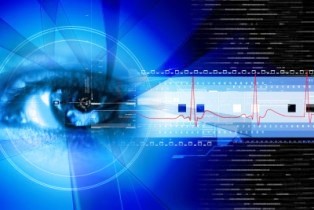Iris Scanning Understanding Iris Recognition Technology!
Biometric iris scanning is becoming a more popular and viable form of biometrics technology used today. Compared to other automated biometric technologies, this one is fairly young, since biometric eye scanners were in patented back in 1994.
The iris is the ring of color that goes around the pupil in the human eye. Every human has an iris and no one has the same pattern.
The distinctive pattern of the iris is formed in uteri randomly, providing an accurate method of identification and authentication.
If you’re interested in eye biometrics, here is a closer look at iris recognition technology.
Today, biometrics eye scanners are already in use. It is used at various high security access points, such as research laboratories and government buildings.
Biometrics Iris Scanning - How It Works!

Although eye scanning may seem difficult, a CCD digital camera is actually at the heart of biometric eye scanning systems. Near infrared light and visible light are used to take a picture of the eye in high contrast. The pupil appears black in near infrared light, which means the computer has an easier time isolating the iris from the pupil.
Once you look into biometrics eye scanners, the camera focuses on the eye. In most cases, you’ll be required to have your eye between 3-10 inches away from the scanning camera, although some scanners can scan the eye at up to 16 inches away. When the picture is taken, there are several areas that are located by the computer, including the following:
- The pupil’s edge
- The pupil’s center
- The eyelashes
- The eyelids
- The iris’ edge
After scanning these areas, the computer goes on to analyze the eye patterns. Then, it turns those patterns into a special code. Once collected, this information is stored within a computer biometrics database for future reference.
The Benefits of Iris Scanning
The use of scanners come with a variety of excellent benefits today. One of the main benefits of using this type of scanning technology is that the eye stays stable through the years.
Even though the color or shape of an eye is changed, the texture stays the same. The use of iris biometrics scanning technology even works on people who are blind - they only have to have an eyeball that can be scanned.
Another benefit of iris recognition technology is that it provides excellent scanning accuracy. Within eye biometric technology, it’s one of the most accurate technologies currently available. Since the eye is so unique, twins will not even have the same iris pattern, making it very unlikely that two similar textures will ever be found.
This eyeball biometric technology offers such excellent accuracy because over 240 points of reference are used within an iris pattern to create a match. This is significant, when compared to fingerprints, which only use approximately 60 points of reference.
Current And Future Scanning Uses
Some airports are beginning to consider the use of this biometrics scanning technology in the future, while some are already implementing biometric eye scanners.
Hotels are also experimenting with this eyeball scanning technology, considering the use of pupil recognition instead of issuing room keys to patrons. In the future, many forms of physical access based identification may be replaced with this scanning technology.
Since the eye is not something easily stolen, iris scanning provides an option that helps address the potential problems of fraud and password management.
Biometrics is basically the recognition of human characteristics that are unique to each human, which can include facial recognition, fingerprints, voice recognition, retina scans, palm prints, and more.
Are you looking to secure your home or business? Today you can find a variety of security devices that use the latest biometrics technology, including safes, locks, time clocks, and even computers.
Return to the top of Iris Scanning
Biometric-Security-Devices.com
Free Credit Repair Ebook
The Secret To Better Credit!
Do You Want To Take Your Credit Score To The Next Level?



